


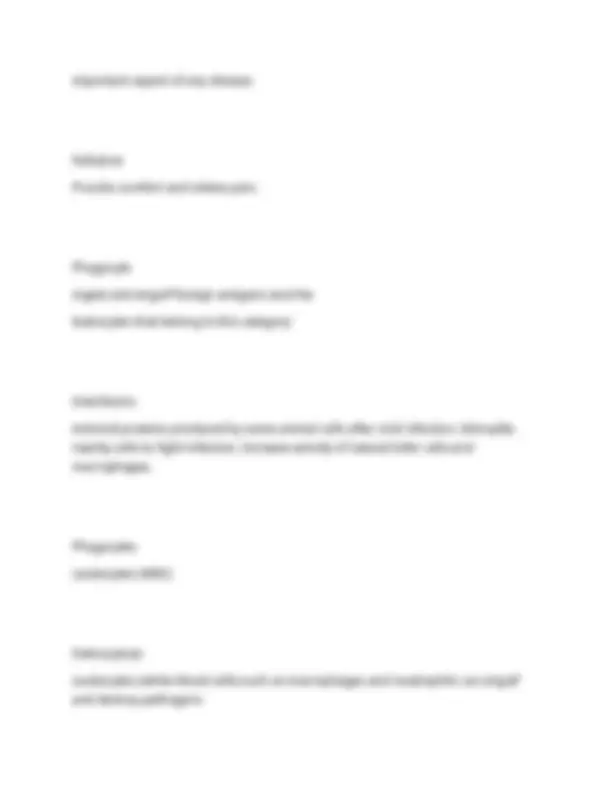
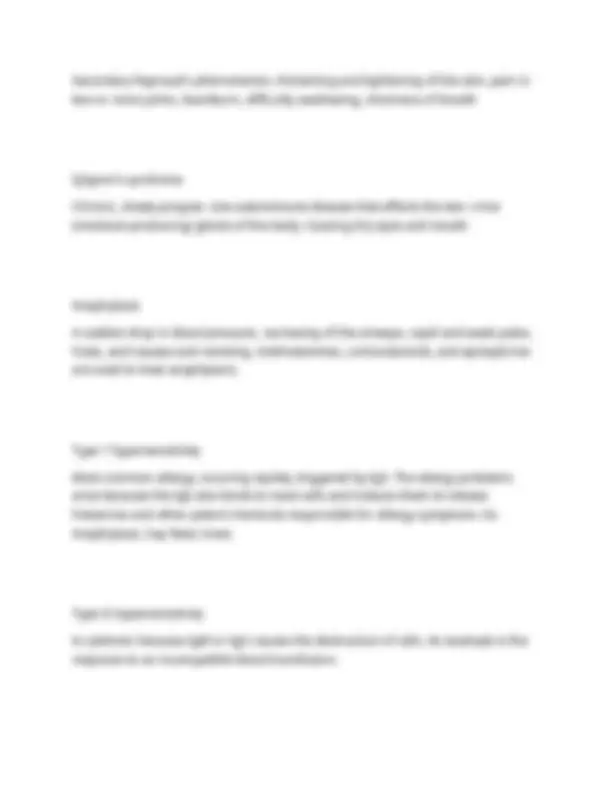
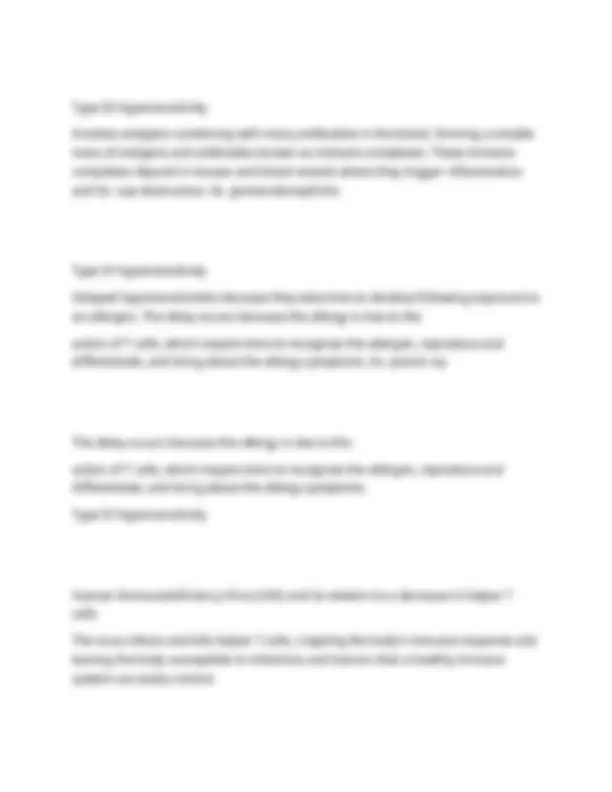

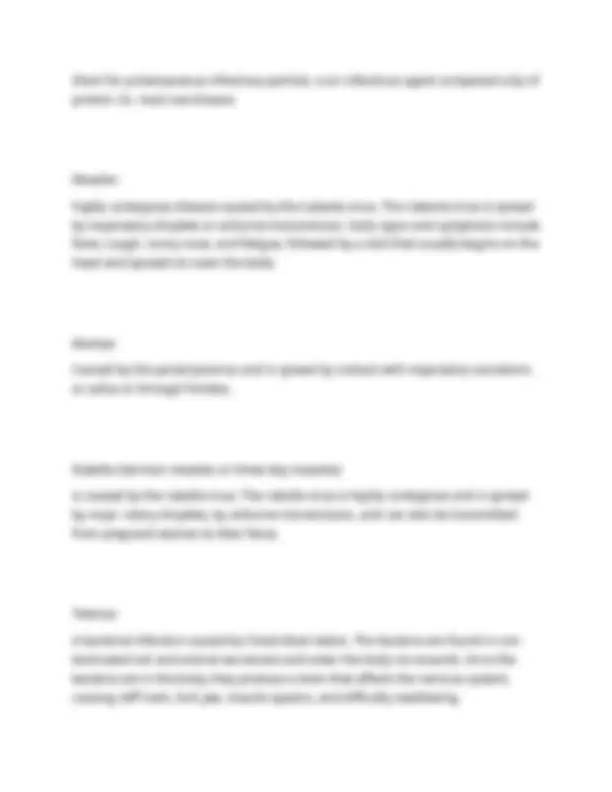
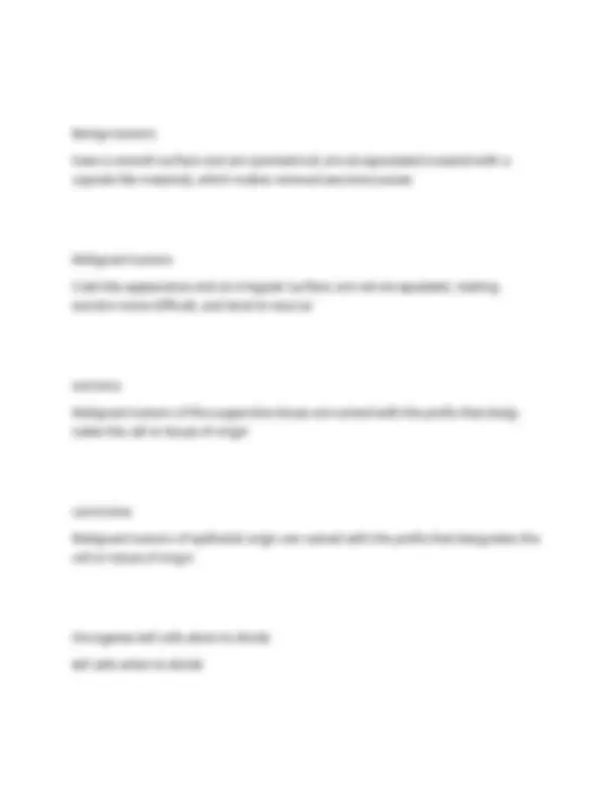




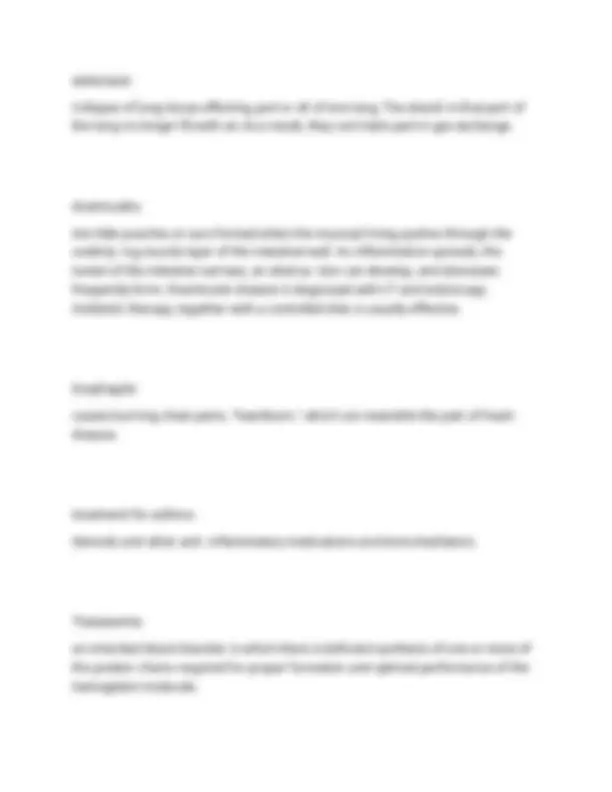
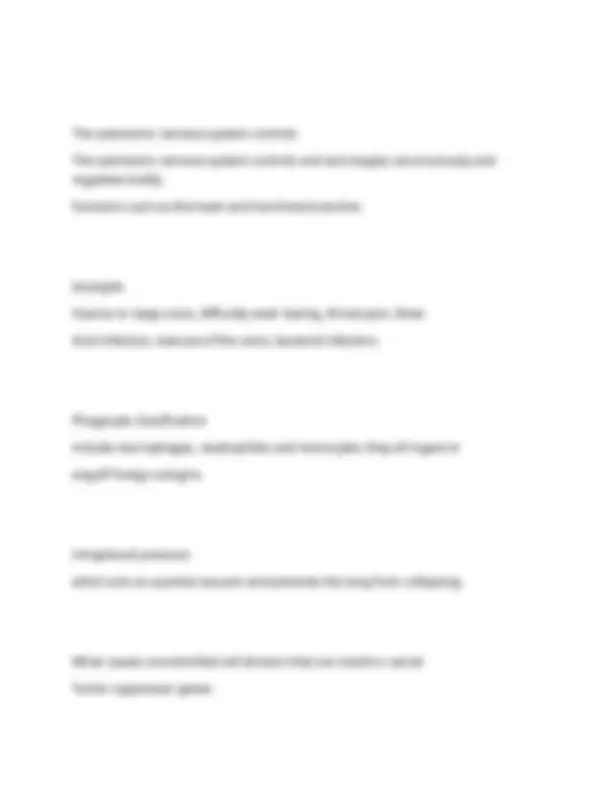
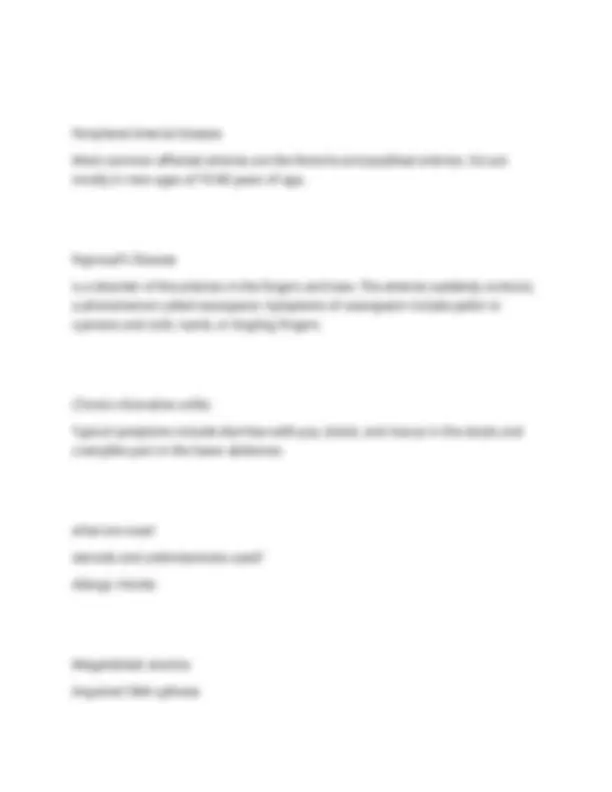





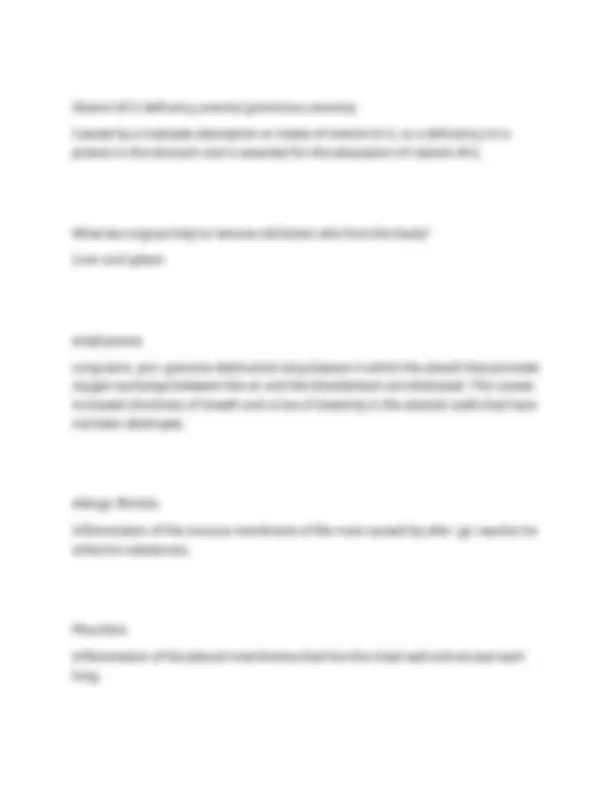
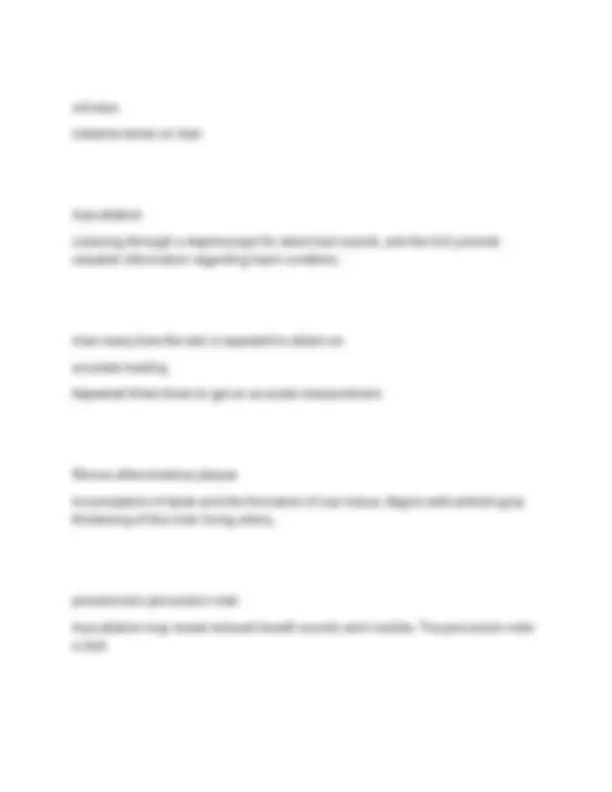
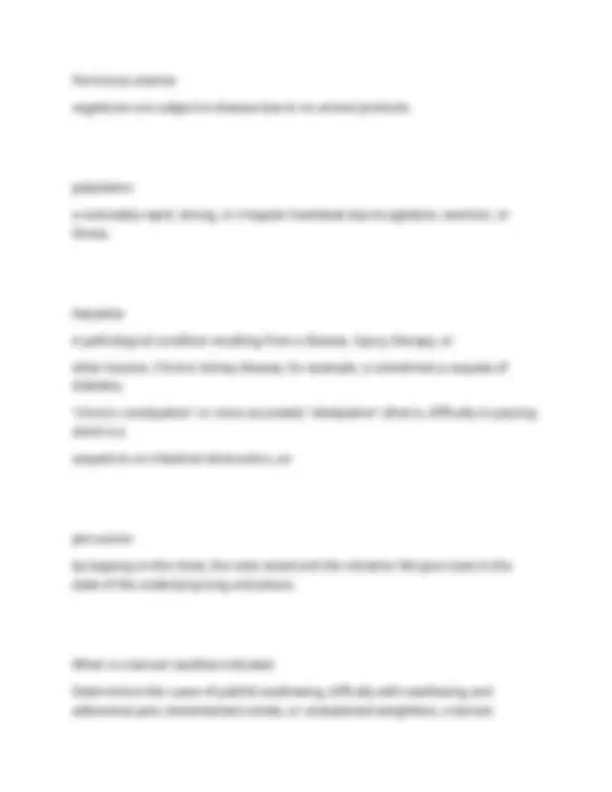
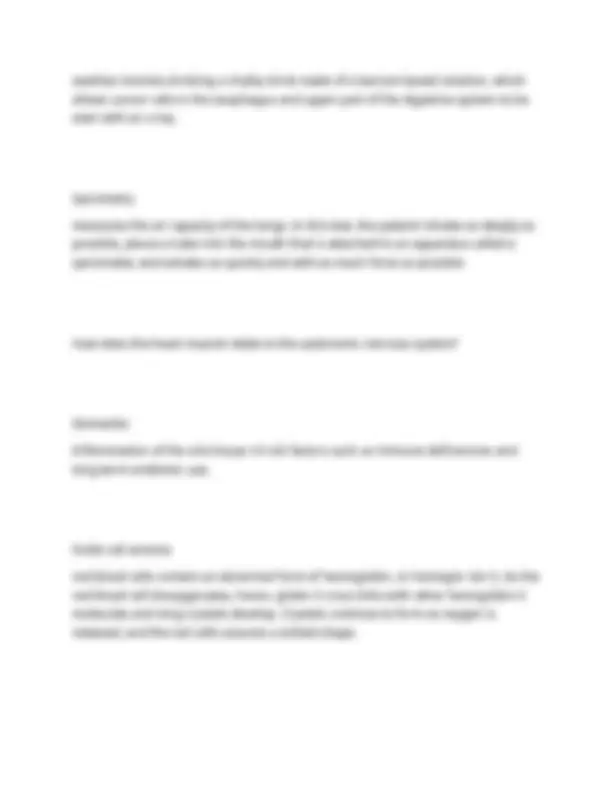



Study with the several resources on Docsity

Earn points by helping other students or get them with a premium plan


Prepare for your exams
Study with the several resources on Docsity

Earn points to download
Earn points by helping other students or get them with a premium plan
Community
Ask the community for help and clear up your study doubts
Discover the best universities in your country according to Docsity users
Free resources
Download our free guides on studying techniques, anxiety management strategies, and thesis advice from Docsity tutors
A concise overview of key concepts in pathology, focusing on disease processes and the body's response to illness. It covers topics such as homeostasis, disease definitions, acute and chronic conditions, and the immune system's role in fighting infections. The document also touches on various types of hypersensitivity, infectious agents, and tumor classifications, offering a foundational understanding of disease mechanisms and their impact on human health. It is useful for students studying basic pathology and immunology, providing a quick reference guide to essential terms and concepts. This study guide is designed to help students prepare for exams by summarizing key definitions and concepts related to disease and immunity. It covers a range of topics, including homeostasis, types of diseases, the immune system, and various infectious agents.
Typology: Exams
1 / 33

This page cannot be seen from the preview
Don't miss anything!


























Homeostasis Relatively stable internal conditions under fluctuating environmental conditions. In homeostasis, the body's organ systems normally maintain temperature, pH, blood composition, and fluid levels within a precise range and cor- rect any fluc disease a deviation from normal structure or function in the body that interrupts or modifies the performance of vital functions. For example, the amount of glucose in the blood is tightly regulated to ensure that organs receive an adequate supply of energy. Pathology Study of disease, epecially the structural and functional changes assoicated with causes, mechaisms, signs, and symtpoms, treatments and prevention. Health is the condition in which the human body per- forms its vital functions normally. In health the body's various organ systems function optimally and a person can participate fully in his or her life.
Prognosis a disease predicted course and outcome. The prognosis may state the chances for complete recovery, predict the permanent loss of function, or give probability of survival. Diagnosis the process of identifying a disease or disorder. Several types of information are used for diagnosis, including signs and symptoms, which can be quite specific and therefore helpful for diagnosing certain diseases. Acute Disease has a sudden onset and short duration. Influenza, measles, and the common cold are examples of acute infections. Terminal Disease that will end in death. Chronic Disease has a slower, less severe onset and a long dura- tion of months or years. Examples of chronic diseases include heart disease, cancer, stroke, diabetes, and arthritis.
Morbidity is the number of cases of a disease in a population Prevalence is a percentage of a population that is affteced with a particular disease at a given time Incidence The number or rate of new cases of a particular condition during a specific time. Idiopathic a diseas that is not known is said to be. Pathogenesis Cause of a disease leads to the anatommical and physiological changes in the body that ulimately result in disease Etiology
important aspect of any disease Palliative Provide comfort and relieve pain. Phagocyte ingest and engulf foreign antigens and the leukocytes that belong to this category Interferons Antiviral proteins produced by some animal cells after viral infection. Stimualte nearby cells to fight infection. Increase activity of natural killer cells and macrophages. Phagocytes Leukocytes (WBC) Pathocytosis Leukocytes (white blood cells) such as macrophages and neutrophils can engulf and destroy pathogens
Cell-mediated immunity provides a defense against viruses, abnormal cells, and other intracellular pathogens, and it is the arm of the immune system responsible for rejecting tissue grafts and organ transplants. T lympho- cytes (or T cells) are responsible for cell- mediated immunity. Memory B cells responsible for a more potent and rapid antibody response during subsequent exposures to the same antigen. Helper T cell Clones and stimulates antbody production by plasma cells, increase pahgocytosis, and stimulate cytotoxic t cells and natural killer cells. Reynaud's phenomenon Lupus Chronic autoimmune disease that can affect various parts of the body, including the skin, joints, heart, lungs, blood, kidneys, and brain. Scleroderma
Secondary Raynaud's phenomenon, thickening and tightening of the skin, pain in two or more joints, heartburn, difficulty swallowing, shortness of breath Sjögren's syndrome Chronic, slowly progres- sive autoimmune disease that affects the exo- crine (moisture-producing) glands of the body. Causing Dry eyes and mouth Anaphylaxis A sudden drop in blood pressure, narrowing of the airways, rapid and weak pulse, hives, and nausea and vomiting. Antihistamines, corticosteroids, and epinephrine are used to treat anaphylaxis. Type 1 hypersensitivity Most common allergy, occuring rapildy, triggered by IgE. The allergy problems arise because the IgE also binds to mast cells and induces them to release histamine and other potent chemicals responsible for allergy symptoms. Ex. Anaphylaxis, hay fever, hives Type II Hypersensitivity Is cytotoxic because IgM or IgG causes the destruction of cells. An example is the response to an incompatible blood transfusion.
Hodgkin's lymphoma Marked by the presence of a type of cell called the Reed-Sternberg cell. Hodgkin's lymphoma treatment chemotherapy, radiation therapy, and bone marrow or stem cell transplant. Endemic When diseases are at low levels in a certain population Epidemic Unusual large number of a population in a specific areas (flu) Pandemic epidemic has spread to include several areas worldwide, Horizontal transmission describes transmission of an infectious disease from a reservoir to a sus- ceptible human.
Direct transmission occurs when an individual is infected by contact with the reservoir. Vertical transmission Other infectious diseases are transmitted from one generation to the next, as when syphi- lis, HIV/AIDS, or ophthalmia neonatorum (an eye infection) are transmitted to newborns from infected mothers. Parenteral route Punctures, injections, bites, and surgery can allow microorganisms to be deposited directly into the tissues below the skin. ex. Hep C anf HIV Nosocomial infections hospital-acquired, infections are infections acquired in a health care facility. Reservoirs source of an infectious agent
Short for proteinaceous infectious particle, is an infectious agent composed only of protein. Ex. mad cow disease Measles highly contagious disease caused by the rubeola virus. The rubeola virus is spread by respiratory droplets or airborne transmission. Early signs and symptoms include fever, cough, runny nose, and fatigue, followed by a rash that usually begins on the head and spreads to cover the body Mumps Caused by the paramyxovirus and is spread by contact with respiratory secretions or saliva or through fomites. Rubella (German measles or three-day measles) is caused by the rubella virus. The rubella virus is highly contagious and is spread by respi- ratory droplets, by airborne transmission, and can also be transmitted from pregnant women to their fetus. Tetanus A bacterial infection caused by Clostridium tetani. The bacteria are found in con- taminated soil and animal excrement and enter the body via wounds. Once the bacteria are in the body, they produce a toxin that affects the nervous system, causing stiff neck, lock jaw, muscle spasms, and difficulty swallowing.
Benign tumors have a smooth surface and are symmetrical; are encapsulated (covered with a capsule-like matarial), which makes removal (excision) easier. Malignant tumors Crab-like appearance and an irregular surface; are not encapulated, making excision more difficult, and tend to reoccur sarcoma Malignant tumors of the supportive tissue are named with the prefix that desig- nates the cell or tissue of origin carcinoma Malignant tumors of epithelial origin are named with the prefix that designates the cell or tissue of origin Oncogenes tell cells when to divide tell cells when to divide
Generalized injecting the contrast dye into the blood stream to exam heart and thoracic vessels radio graphically Magnetic resonance imaging (MRI) is a type of scanning that uses a magnetic field, not x-rays, to induce tissues to emit radio waves. ultrasonography high-frequency sound waves are reflected off internal tissues to produce an image called a sonogram. Ultrasound does not involve radiation, is easy to use, and is inexpensive. Computed tomography (CT) a scanning type of radiography that creates a three- dimensional picture of the inside of the body with an x-ray machine Grading cancer is helpful in making a prognosis that reflect the characteristics of cells within these organs. Staging cancer
help to develop a treatment plan and help to predict the prognosis of the disease, based on its size and the extent of the disease spread. Radiation Therapy Places at the site of specific tissues to destroy as few normal ceels as posible. Are high-energy rays to damage DNA of cells, interfering with cell division and growth. Both normal and cancer cell DNA is damaged during radiation therapy. Chemotherapy Uses medications that target rapidly dividing cells and, therefore, kills cancer cells and some normal cells. Normal rapidly dividing cells include blood cells, bone marrow cells, cells of hair follicles, and cells lining the digestive tract. The side effects of chemotherapy are temporary and can often be treated. What is the single greatest avoidable risk factor for cancer mortality worldwide, causing an estimated 22% of cancer deaths per year. Tobacco HPV causes cervical cancer
Heterozygous When you have two different alleles dominant allele one whose trait always shows up in the organism when the allele is present Recessive only manifest themselves when the person is homozygous for the trait Achondroplasia A form of human dwarfism caused by autosomal dominant disorder. Cystic Fibrosis Affects glands that secrete mucus, leading to recurrent, severe respi- ratory infections and gastrointestinal disorders caused by an autosomal reciessive disorder Sickle Cell Anemia
a disorder in which abnormal hemoglobin causes deformed red blood cells, anemia, and damage to blood vessel caused by a autosomal receissive disorder Huntingtons disease a neurological disorder that is caused by autosmoal dominant disorders. Turner's Syndrome The presence of only one X chromosome Klinefelter's Syndrome The presence of an extra X chromosome Hydrocephalus a congenital disorder that has accumulation of fluid in the spaces of the brain Pericardium A double- layered membrane, encloses the heart within the pericardial cavity